Do you know what metrics you should be tracking to strike employee engagement gold? We’ve compiled a list of 10 important employee engagement KPIs and how they fit into your internal communications strategy.
For most businesses, engaging employees is an ongoing process that shifts as the needs of the company evolve. The ways that communicators choose to track and measure employee engagement are fluid but necessitate having key performance indicators (KPIs) to benchmark data over time.
In this article, we look at the ins and outs of employee engagement KPIs, including ten key metrics to consider when setting your employee engagement goals.
From traditional metrics like turnover rates and absenteeism to more nuanced indicators such as employee net promoter score (eNPS) and job satisfaction levels, we’ll explore how each KPI can provide valuable insights into your team’s engagement and morale. Plus, we’ll walk you through how to measure employee engagement KPIs easily using an employee engagement platform like ContactMonkey.
Read on as we unlock the potential of your workforce by mastering the art and science of employee engagement KPIs!
Revive employee engagement with targeted, interactive emails and newsletters
Book a 15 minute call with one of our team members
What Is an Employee Engagement KPI?
Employee engagement key performance indicators (KPIs) are the metrics that companies choose to track and measure as part of their employee engagement goal-setting. The term is often used interchangeably to refer to both the metrics being collected and the goal itself.
Which metrics count as KPIs for employee engagement aren’t necessarily consistent. The “key” indicators differ from company to company and even year to year depending on organizations’ goals, strategies, and priorities.
A company with little turnover may focus on other metrics, setting goals for employee engagement KPIs in areas where they seek to improve. On the other hand, turnover may be central to their employee engagement strategy, with their low turnover rate being a key indicator of their engagement strategy performing well.
Why Are Employee Engagement KPIs Important?
Employee engagement KPIs give companies an objective way to set clear employee engagement goals, strategize based on quantitative data, and understand whether goals are being met.
Think of it this way—if your quarterly goal was having “high employee engagement,” would you know where to start? How would you know whether or not goals have been met? With the cost of employee disengagement so high, having a clear strategy for measuring engagement and strategizing based on the results is invaluable for a company.
Keeping a pulse on employee engagement analytics enables leaders to make informed decisions that directly contribute to better team and company success.
A company that sets employee engagement KPIs knows what success looks like and has a structured way to achieve it. If you primarily measure engagement through eNPS ratings, for example, you know you need a specific eNPS goal and a way to track eNPS at your company.
To see if you’re meeting your targets, you’d send out an eNPS survey, analyze the results, and compare your score against historical eNPS results as well as your goals for the quarter. From there, it would be clear whether you were hitting your targets or needed to put more work into improving engagement at your organization.
How much is low employee engagement costing you?
Measure your internal comms ROI
Top 10 Employee Engagement KPIs For Success
The employee engagement KPIs you choose to focus on will differ based on what your organization is prioritizing.
Not sure where to start with measuring employee engagement KPIs? Or which KPIs will best indicate success for your organization’s goals?
Below is a list of common employee engagement KPI examples to track and measure as as part of your goal-setting. We’ve also provided explanations of why you might find each metric useful as a KPI for employee engagement.
1. eNPs Score
An Employee Net Promoter Score (eNPS) is a popular way for employers to measure employee attitudes toward their organization. It is calculated by asking employees to answer a single question: “How likely are you to recommend our company as a place to work?”
Employees place their answers on a scale of 0-10, and are sorted into one of three categories: Promoters (9–10), Neutrals (7–8), or Detractors (0–6).
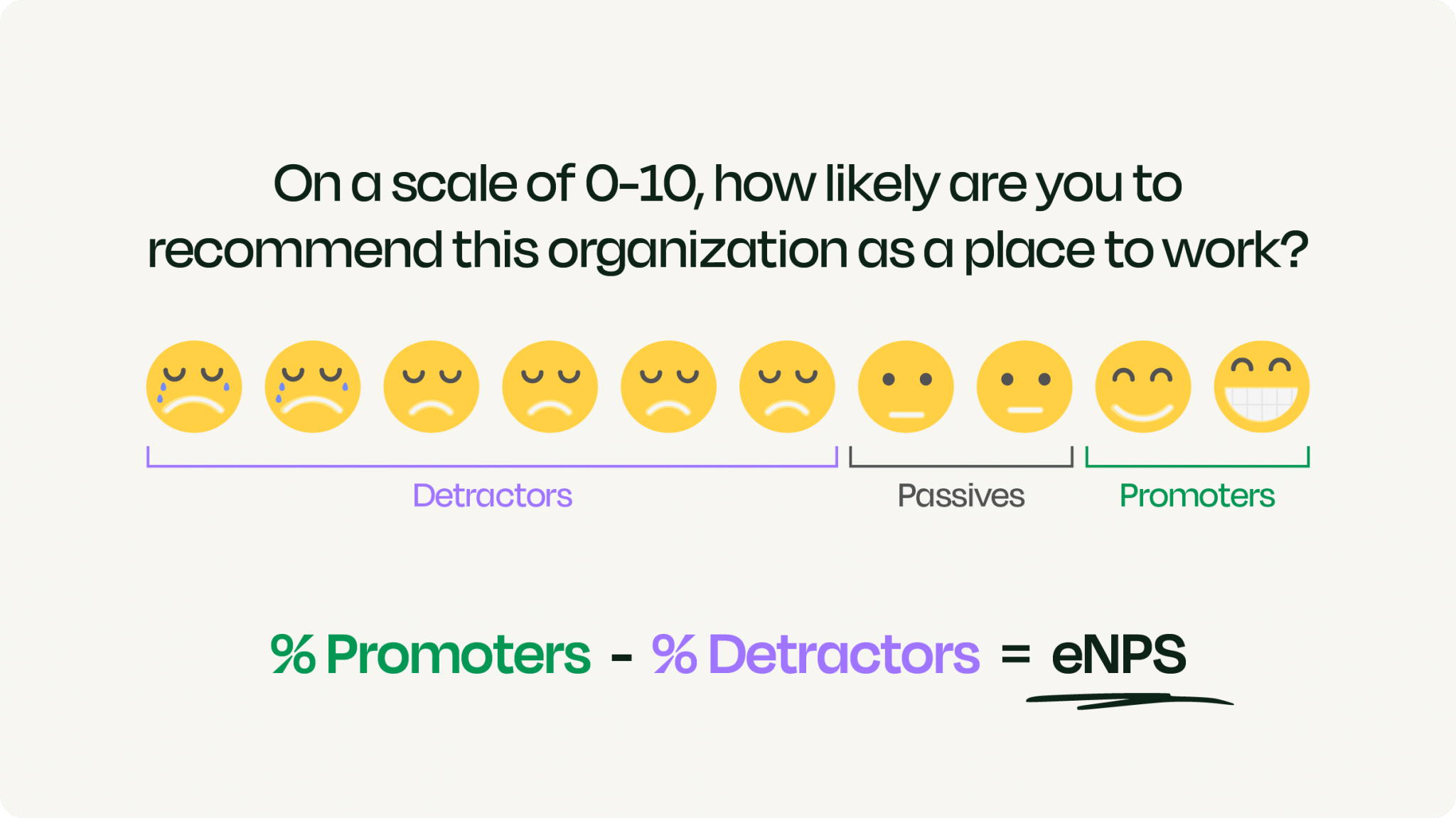
The score is then calculated by subtracting the percentage of detractors from the percentage of promoters. This means that you could end up with either a positive or negative eNPS.
Why eNPS scores make a good employee engagement KPI:
eNPS is an extremely common KPI for employee engagement for several reasons. For one thing, it is a metric that is extremely simple to collect and calculate. Given that an eNPS survey is only a single question, getting employees to respond to the survey is quick and painless. With higher survey participation, you can get a more thorough overview of engagement at your whole company, which makes it a useful metric to use in goal-setting.
Plus, calculating your eNPS is a very straightforward way of putting a number value to something that can be quite subjective, like employee engagement. And if you’re using an employee engagement tool like ContactMonkey, it can even automatically calculate your eNPS score for you as employees answer your survey.
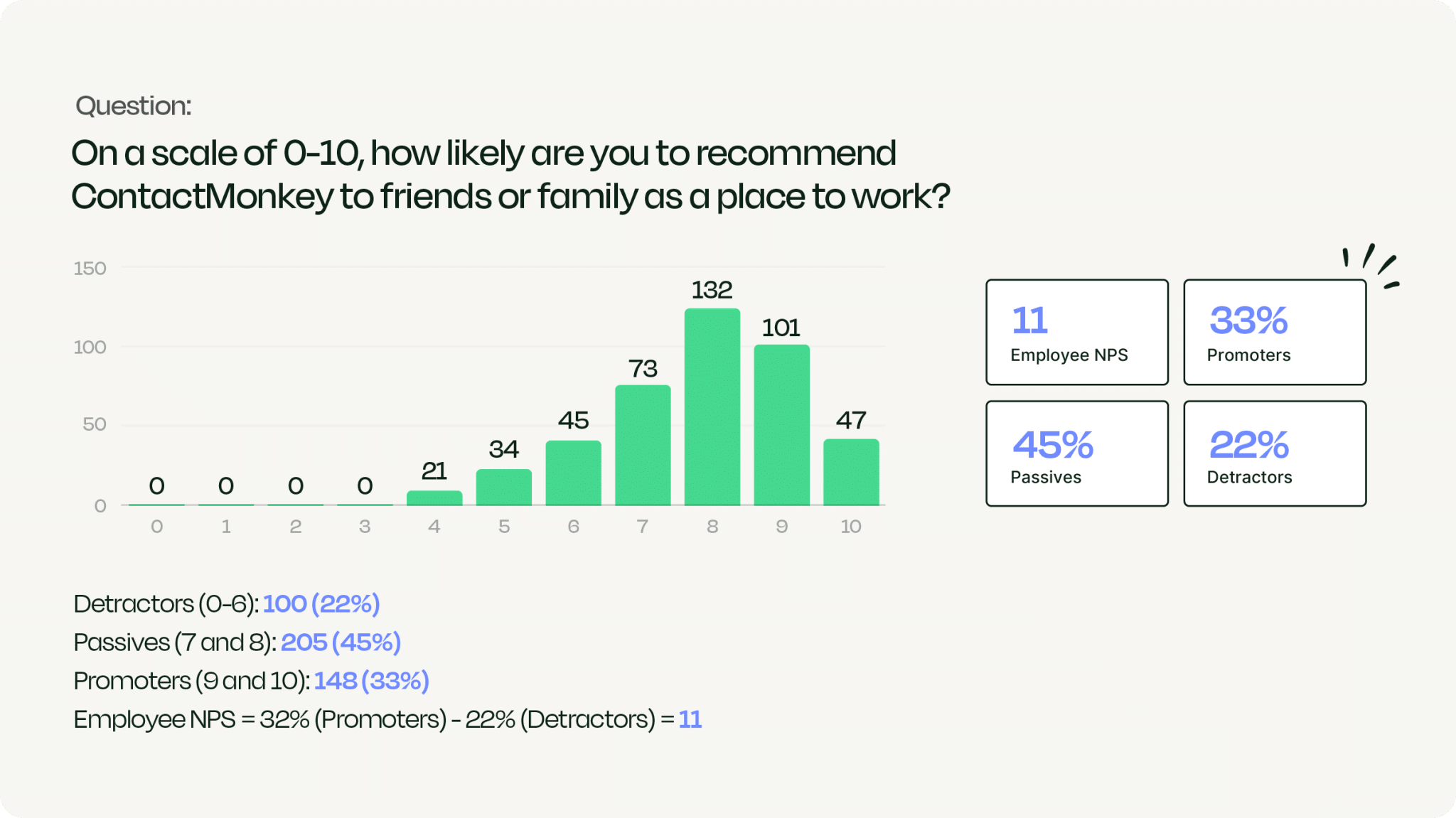
Find out more on how using technology can increase employee engagement and collaboration in your teams.
2. Employee Engagement Index
An employee engagement index is a way for employers to quantify engagement along multiple axes or dimensions based on the responses to a longer employee survey. These dimensions may include things like job satisfaction, pride in the company, loyalty, and the overall willingness to go above and beyond in one’s role.
To calculate an employee engagement index score, organizations first design a survey with a series of statements related to engagement, asking employees to rate their agreement on a Likert scale (usually ranging from 1 to 5).
As survey responses come in, they get aggregated to produce an average score. Alternatively, you can break responses down into sub-categories or dimensions of engagement for more detailed insights.
Why an employee engagement index is a good KPI to measure employee engagement:
The beauty of an employee engagement index lies in the fact that, like eNPS, it presents a way to turn subjective perceptions into tangible data. However, while your employee engagement index score is still a single number, this metric encapsulates more nuance than an eNPS score might.
By integrating multiple dimensions of engagement into one metric (or a handful of them), an employee engagement index provides a more rounded view of engagement. This holistic approach captures the complexity of employee attitudes and can offer more accurate insights than simpler single-factor measures.
An employee engagement index is a more direct way to measure engagement than most, given that it seeks to quantify precisely the levels of engagement at your organization. Plus, because it requires a detailed survey, you can begin to identify your problem areas when it comes to employee engagement.
3. Survey Response Rate
Apart from the insights you glean from conducting an employee engagement survey, the percentage of your employees that respond to said survey can itself be an excellent indicator of your employees’ levels of engagement.
When asked to perform a task like filling out a survey, engaged employees make it a priority, doing so as soon as possible. Plus, they’re more likely to want to offer their feedback and thoughts to employers. Disengaged employees, however, may procrastinate, not bother participating, or not see the point in contributing their feedback.
Why your survey response rate makes a good employee engagement KPI:
Okay, so your survey response rate can be a helpful metric, but is it actually key? We’d argue yes!
With your employee engagement strategy so dependent on employee feedback, high survey participation is your best bet for getting an accurate picture of engagement at your organization, setting realistic goals, and finding strategic targets for your employee engagement initiatives.
If your survey response rate is low, you’ll be operating without the data necessary to effectively improve engagement at your organization. For that reason, survey response rate is the employee engagement KPI you should focus on and plan around before any others. Only once you’re confident that you’re consistently getting high participation in every survey that you send should you redirect your efforts.
Pulse surveys that actually engage employees
Get instant feedback with our interactive survey tools—without switching platforms.
4. Employee Turnover and Retention Rates
Your turnover rate and retention rate are two opposing ways of answering the same question—can your organization hold onto its talented, valuable employees?
Why employee turnover and retention make good employee engagement KPIs:
High employee engagement typically correlates with high retention and low turnover rates. Unsurprisingly, when employees feel engaged at work, they’re more likely to want to stay at their company.
High turnover rates can also be a direct driver of further turnover and low engagement. When employees lose crucial team members or are expected to take on excess responsibilities because of a low headcount, they may begin to lose their motivation, putting them in danger of adding to the drain of talent from your company.
For this reason, turnover and retention are common KPIs to measure employee engagement, with many businesses prioritizing retention goals in their engagement strategy.
5. Successful Hires
Your successful hire rate refers to the percentage of new employees who make it through their probation period and become permanent full-time employees. A low rate of successful hires might look like multiple employees failing to meet expectations during their probationary period, or it might mean high employee attrition rates during the early stages of the onboarding process.
With the cost and time commitment of recruiting and onboarding new employees so high, this employee engagement KPI is high stakes! When employees are not making it through their probation period, it’s a strong indication that something is wrong with either your company culture or your onboarding process.
Why your rate of successful hires makes a good employee engagement KPI:
The early days of an employee’s tenure in a company provide the building blocks of their future levels of engagement. When onboarding is well thought out, it can help those employees feel immediately comfortable in and connected to their jobs, setting them up for better engagement in the future.
A high rate of successful hires suggests your organization’s onboarding process is effective at preparing new hires to meet job expectations and integrate into the company culture. This is key for small, growing businesses that cannot afford to continuously be hiring for the same jobs. Thus, a high successful hire rate can be a crucial employee engagement KPI for them to focus on.
6. Employee Satisfaction
While employee engagement has more to do with an employee’s feelings of connection and interest in their work and job tasks, employee satisfaction is a more general metric that describes how employees feel about being part of their company.
They’re not the same thing, but there’s no denying that the two are intrinsically linked.
A satisfied employee is not necessarily an engaged employee—you can imagine someone being comfortable in their position but not particularly interested in their day-to-day work, for example.
However, employee satisfaction is often a prerequisite for engagement. When an employee is struggling with elements of their employment outside their actual tasks, it’s harder for them to dedicate the same kind of care and interest to their tasks. And when satisfaction is low enough for long enough, engagement can feel downright impossible.
Why employee satisfaction scores make a good KPI to measure employee engagement:
Employee satisfaction can be complicated to quantify, but it may well be worth making it one of your employee engagement KPI metrics. After all, employee satisfaction is deeply tied to many other indicators of employee engagement, from turnover and retention to productivity to eNPS scores.
By making satisfaction a key part of your engagement strategy and goal setting, you set yourself up for success across a broad spectrum of employee engagement metrics.
Low employee satisfaction acts as an early warning, helping you identify potential issues and address concerns before they begin to negatively impact your other employee engagement KPIs. This proactive approach makes employee satisfaction scores not just an indispensable metric for measuring current engagement levels, but a tool for promoting long-term engagement.
7. Employee Communications Engagement
Your internal communications are a key employee engagement tool, but their usefulness only extends as far as employees are willing to engage with them in return. While highly engaged employees may be regularly checking their various internal communication channels, disengaged employees may choose to skim important notices or even leave things unread in their inboxes for hours and days on end.
Internal communication metrics like newsletter and email clicks, open rates, and read times give leaders and communicators a better understanding of how employees interact with their communications.
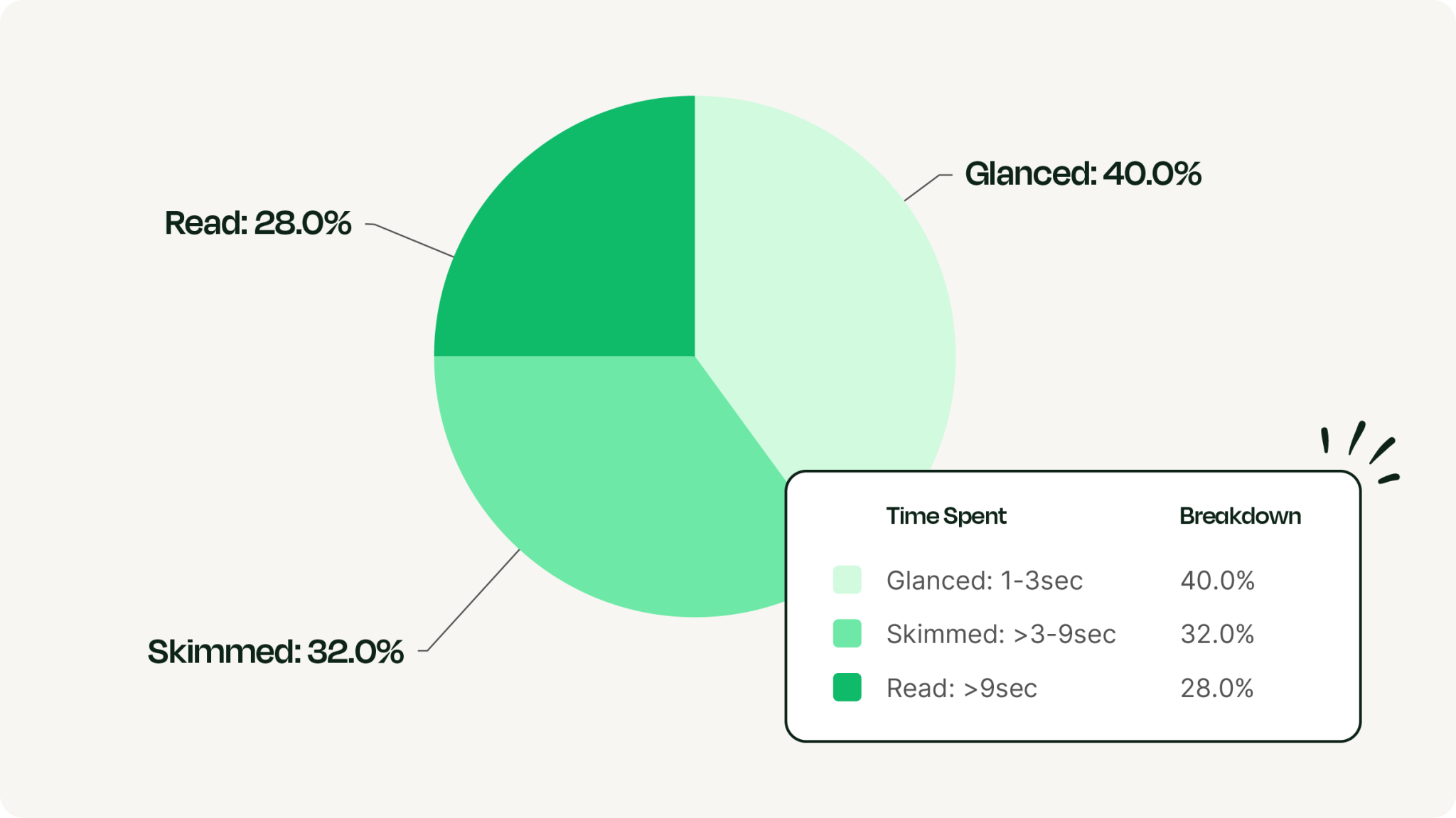
Why internal communication metrics make good employee engagement KPIs:
Internal comms are a crucial part of how you both measure and combat low engagement, so getting your comms engagement squared away should be near the top of your priority list. To do so, you’re going to need information about what type of communication your employees are responding to.
Plus, your internal communication tracking metrics can help lend context to other employee engagement KPIs you’re tracking. For example, if your survey response rate is low, taking a look at the open rate for the reminder emails can lend insight into why that may be. Are employees truly choosing not to answer the survey, or are they perhaps not opening the email?
Once you have the answer to that question, you can better strategize on how to improve your response rate.
8. Productivity
Productivity is an employee engagement metric that can be measured in multiple ways, but at its most basic it is a measurement of the amount of work achieved relative to the time spent. As a general rule, engaged employees are more motivated and dialed into their work, resulting in more efficiency and higher productivity.
Why productivity is a useful KPI for employee engagement:
Choosing productivity as an employee engagement KPI emphasizes the results of having an engaged workplace, measuring engagement via its tangible outcomes in the workplace.
Organizations are always concerned with their business outcomes, and tracking employee engagement through productivity highlights the ways the two are inextricably linked. This in turn lends urgency to your need to address any employee engagement pitfalls within your organization.
Productivity is also on the easier end of quantifiable metrics, with most organizations having an existing process in place for measuring employee productivity. That being said, what productivity looks like will likely differ between different teams.
Performance reviews email template
Wrap up review season with ease using our email template.
9. Employee Performance Ratings
Employee Performance Review Ratings, which assess the effectiveness and contributions of an employee over a specific period, can function as a KPI for employee engagement by providing insights into how actively engaged employees are with their roles and responsibilities.
While this isn’t always the case, engaged employees are often the high performers within an organization. And when teams have high-performance ratings overall, chances are those leaders are doing a great job engaging their team members as a whole!
Why employee performance review scores make a good employee engagement KPI:
One obvious benefit of using performance review ratings as a measurement of employee engagement is that you likely already perform regular performance reviews. In other words, you probably already have a system in place and historic metrics available for analysis.
Employee performance ratings are also another metric, like productivity, that makes the link between employee engagement and positive business outcomes explicitly clear.
10. Internal Promotion Rate
Your internal promotion rate is a measurement of the percentage of job vacancies your company fills through promoting existing employees versus hiring external candidates.
When employees see clear paths for advancement within their company, it significantly boosts employee morale, job satisfaction, and loyalty. Access to growth opportunities can thus be a leading factor in how engaged and motivated an employee feels.
Why your internal promotion rate makes a good employee engagement KPI:
Internal promotion rate is a less direct measurement of employee engagement than some of the other employee engagement KPI examples on this list. However, that’s not to say it doesn’t have its strengths as a potential goal-setting metric.
In fact, you can look at your internal promotion rate’s relationship to engagement in two ways. First, a higher rate of internal promotion is indicative of a positive workplace culture where employees see a long-term future for themselves and are motivated to work hard and advance within the company.
Secondly, prioritizing internal promotion as part of your employee engagement plan is a fantastic way to create a positive workplace culture, encouraging employees to perform their best with the knowledge their hard work will be rewarded.
How ContactMonkey Can Help You Track And Improve Employee Engagement
If you’re wondering how to measure your employee engagement KPIs, take a deep breath and don’t panic. With top employee engagement software, like ContactMonkey, tracking employee engagement metrics doesn’t need to be complicated or time-consuming.
Contactmonkey allows you to simplify the process of conducting employee engagement surveys. With the drag-and-drop email builder, you can add a pulse survey to any email simply by dragging the survey block where you want it to display, then choosing from the many survey options including emoji reactions, Yes/No, star ratings, and eNPS ratings.
The recurring survey feature even lets you create important surveys ahead of time and drag them into as many emails as you desire, then track how the results change over different survey dates. You can even enable anonymous comments to give employees the opportunity to provide additional context and thoughts.
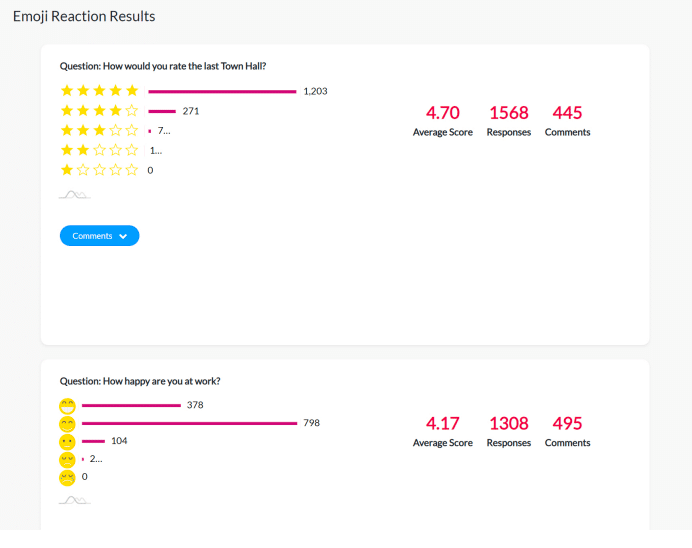
Tracking employee engagement KPIs like eNPS is easy, as the results of any survey you send will be available in real time on your email analytics dashboard. Wondering what your survey response rate is? You can see exactly how many employees have responded to your questionnaire, and even compare multiple survey response rates using our Compare Campaign feature:
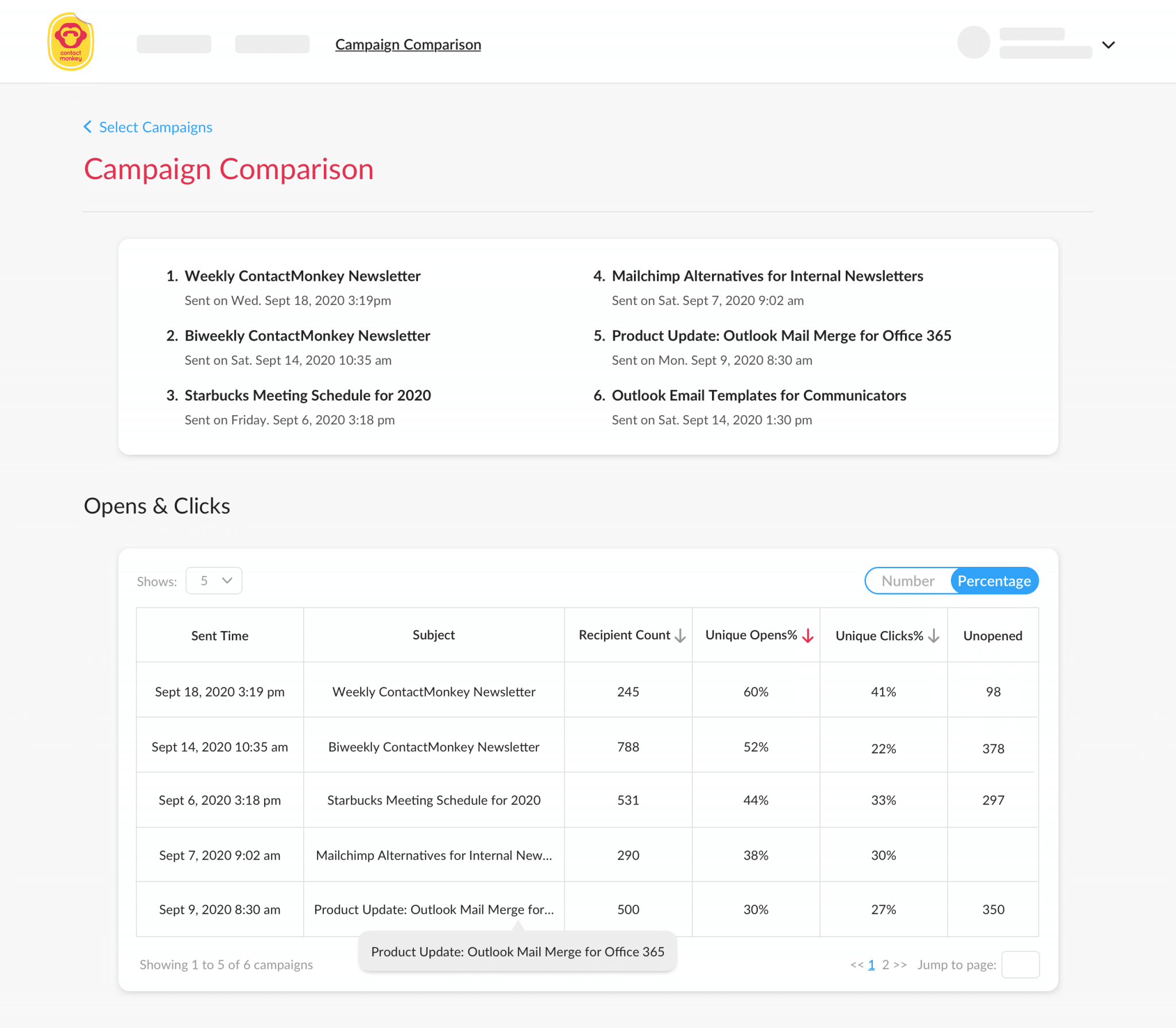
And if employee communication engagement is a KPI that you’re tracking, you can view in-depth email metrics like read time, most engaged employees, individual opens and clicks, and more. You can even view a heat map to get a visual sense of what employees are and aren’t clicking.
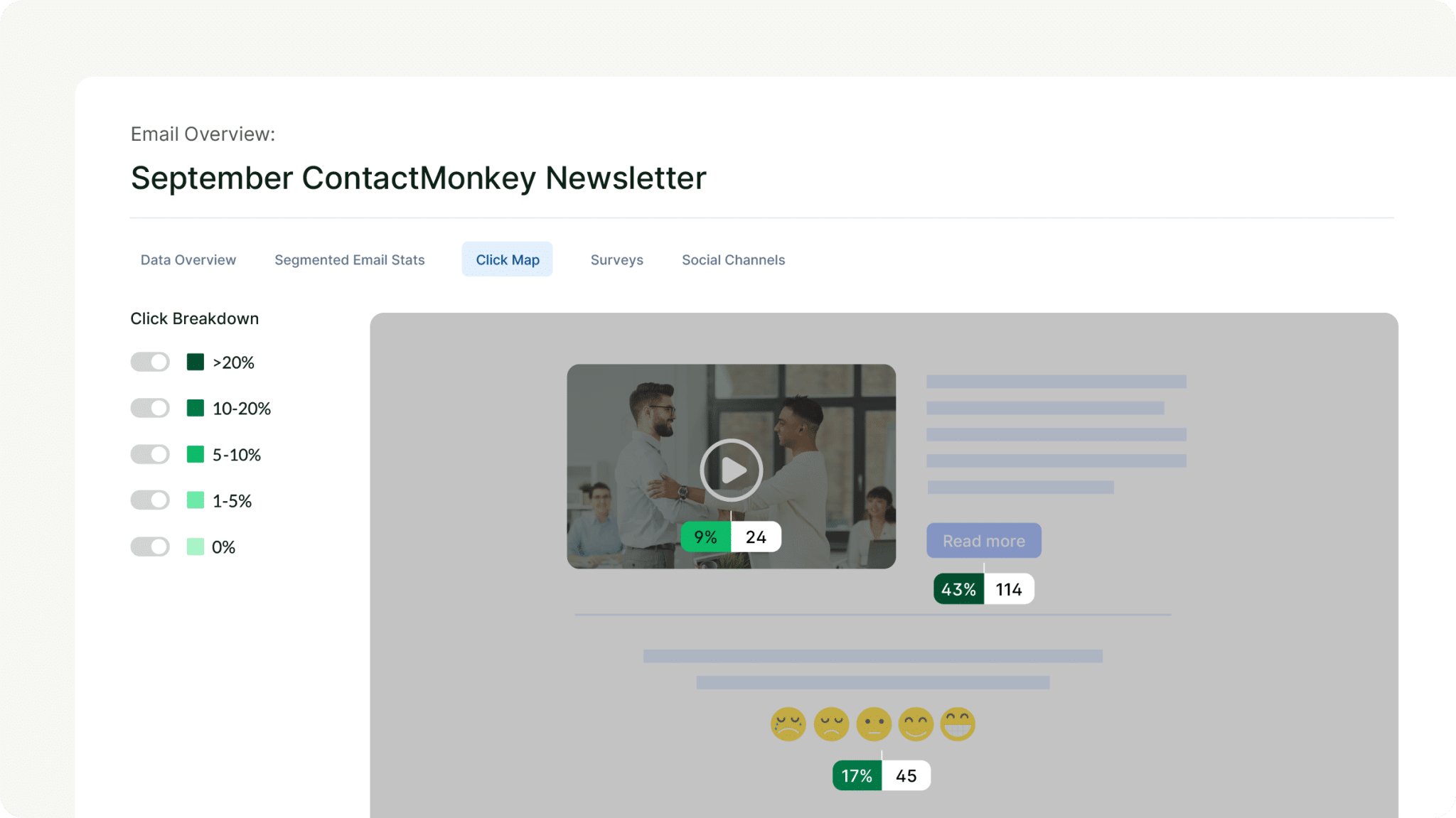
These detailed metrics not only help you measure engagement with your comms, but also reveal your best-performing content. This helps you meet (or exceed) your employee engagement KPI goals.
Measure Your Employee Engagement KPIs with the Right Employee Engagement Tools
From employee retention to productivity to job performance, the stakes of getting employee engagement right are very high. That’s why measuring employee engagement KPIs should be undergone strategically and with the right tools.
To understand the best way to improve employee engagement at your organization, consider bringing in an employee engagement software like ContactMonkey.
We can help you revitalize your internal communications, collect actionable feedback from employees, and track key employee engagement metrics, all in one convenient platform. Happy Tracking!
Interested in adding ContactMonkey to your digital tools for employee engagement? Book a demo to learn how ContactMonkey fits into your employee engagement tech stack.


